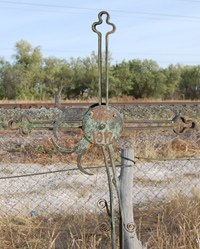
Hildmann Village Website
Hildmann,
Saratov, Volga,
Russia
"Panovka", Volga River, Bergseite,
Russia
Hildmann Village History

Hildmann [Panovka] - founded May 15, 1767
Description made for the Office [Kontora] of Immigrant Oversight by
Deputy of the Chief Justice, Court Councillor Popov, of the colony of
Panovka [Hildmann], inhabited by foreigners, according to information
from the Vorsteher [Head], Bei Sitzer [Witness/Assessor], and best
people of the colony, and by personal observation. October 8,
1798.
This colony is located in the Saratov gubernia [province], in the okrug
[district] of the city of Kamyshin, on the hilly side [Bergseite] of
the Volga river. It is 120 versts [1 verst is about 3,500
feet] from Saratov, 60 versts from Kamyshin, ten from Kamenka, five
from Ilavlya [Leichting], two from Karaulny Buyerak [Köhler], 20 from
the Volga and 27 from the boat landing. There are 143 male
inhabitants and 135 females, totaling 278 souls comprising 41 families,
all of the Roman Catholic faith. They belong to the parish of
the colony of Kamenka, where they have a parish church and
priest. There is a prayer house in this colony. A
schoolmaster, under the supervision of the priest, teaches small
children reading, writing, and religion in a special building.
The properties of this colony are bordered with plots belonging to
Kamenka, Ilavlya [Leichtling], and Karaulny Buyerak [Köhler], by
state-owned steppe land formerly on quit-rent, now held by the adjacent
colonies, and that land allocated in 1798 by the highest rescript to
Lord Privy Councillor Sushkov and Major-General Rezanov. At
the previous Kontora land survey, the colony was allocated arable farm
land of 2,856 desyatinas [1 desyatina is about 2.7 acres], hay lands of
39 desyatinas, and forests of 35 desyatinas. Beyond the
Ilavlya River, they are given 95 desyatinas of arable farm land and
forests. This totals 3,025 desyatinas. The colonists state
that they have 25 desyatinas taken by farmsteads, 20 by roads, and 600
desyatinas under cultivation. Much of the land under
cultivation is poor, but they till it because of need, and because they
have no better land. The remainder of their land is clay,
sand, and saline, on which they pasture their livestock. It
does not produce crops. Of their allocation of hay lands,
only about 30 desyatinas exist, because grass does not grow on the
other places allocated. They have no more than 3 desyatinas
of oak and birch forests. They must purchase feed for their livestock,
and instead of firewood, they use dung fuel. The colony has
shortages of all items mentioned above. There are no means of
alleviating these shortages, even though state-owned land is
nearby. The inhabitants state that is unsuitable, and there
are neither forests nor hay lands there. They also have
shortages of hemp and flax, which do not grow here.
All are engaged in farming. They have a blacksmith and a
shoemaker. All are favorably disposed toward work.
They all live in the most mediocre conditions. All the buildings in the
colony are old and dilapidated. There are no stone or adobe
houses, because there is no source of suitable stone. Yards
are fenced with boards and wattle. Gardens are not far away,
along the Ilavlya River. There are no apiaries [bee colonies]
or orchards. There is one flour mill. The closest
field is behind the farmsteads and the farthest is four versts from the
colony. The farmland has been divided into three fields [they
practice crop rotation – ed]. They till with iron plows and
mostly horses. The fertilize only a little of the
land. Crops are mediocre, and every year a significant
quantity is devoured by gophers. In the course of the summer
of 1798, they consumed more than 64 desyatinas of rye, wheat, oats, and
millet. They know of no means of destroying the gophers, save
flooding their burrows, but no significant number of the gophers can be
destroyed by these means.
The grain is harvested and threshed on threshing floors immediate to
the yards. The inhabitants have been advised of the danger of
fire, and have been instructed to move the threshing floors to a safe
distance. They sell their grain in the city of
Kamyshin. Sale prices vary according to the times.
The past summer of 1797 and the winter of 1798 they sold grain for the
same prices as previously mentioned in descriptions of the area and the
colonies. The community grain storage facility is old, but
constructed in a suitable place. Currently collected in it
are rye, wheat, and oats, by 6 chetvert [1 chetvert is about 210
litres] per family of each. A small part of it has been
allocated to the local inhabitants, but most of it is present.
Authenticated by Court Councillor Popov. Completed with the
signatures of the Vorsteher, Beisitzer, and best people.
For further information: consult No. 1843 The 1798 Description of the
Saratov Colony of Panovka also known as Hildmann No. 124 American
Historical Society of Germans from Russia (AHSGR) 1996.
TO PURCHASE THE HILDMANN 1798 HILDMANN CENSUS FROM AHSGR
Go to: https://www.ahsgr.org/store/ViewProduct.aspx?id=5367210
Population:
|
Year
|
Households
|
Population
|
||
|---|---|---|---|---|
|
Total
|
Male
|
Female
|
||
| 1767 |
45
|
134
|
64
|
70
|
| 1769 |
41
|
136
|
64
|
72
|
| 1773 |
42
|
164
|
75
|
89
|
| 1788 |
39
|
294
|
181
|
113
|
| 1798 |
41
|
278
|
143
|
135
|
| 1816 |
64
|
348
|
180
|
168
|
| 1834 |
78
|
564
|
273
|
291
|
| 1850 |
87
|
829
|
428
|
401
|
| 1857 |
84
|
930
|
473
|
457
|
| 1859 |
78
|
926
|
486
|
440
|
| 1886 |
193
|
1,469
|
731
|
738
|
| 1891 |
183
|
1,849
|
932
|
917
|
| 1894 |
183
|
1,884
|
961
|
923
|
| 1897 |
|
1,972*
|
981
|
991
|
| 1905 |
|
1,884
|
|
|
| 1911 |
|
2,409
|
|
|
| 1912 |
|
2,587
|
|
|
| 1920 |
341
|
2,290
|
|
|
| 1922 |
|
1,400
|
|
|
| 1926 |
289
|
1,493
|
716
|
777
|
| 1931 |
|
1,929
|
|
|
*Of whom 1,649 were German.

